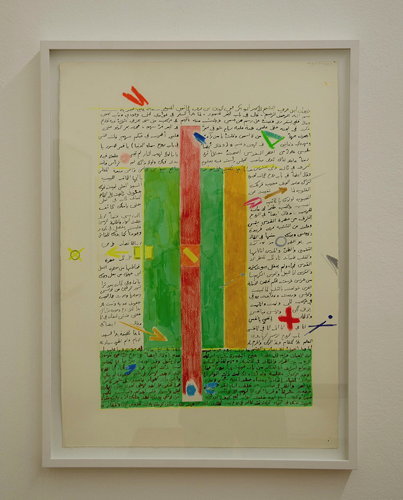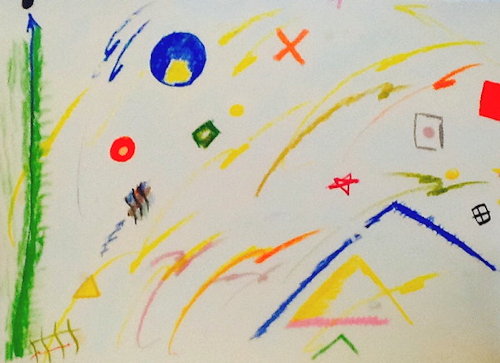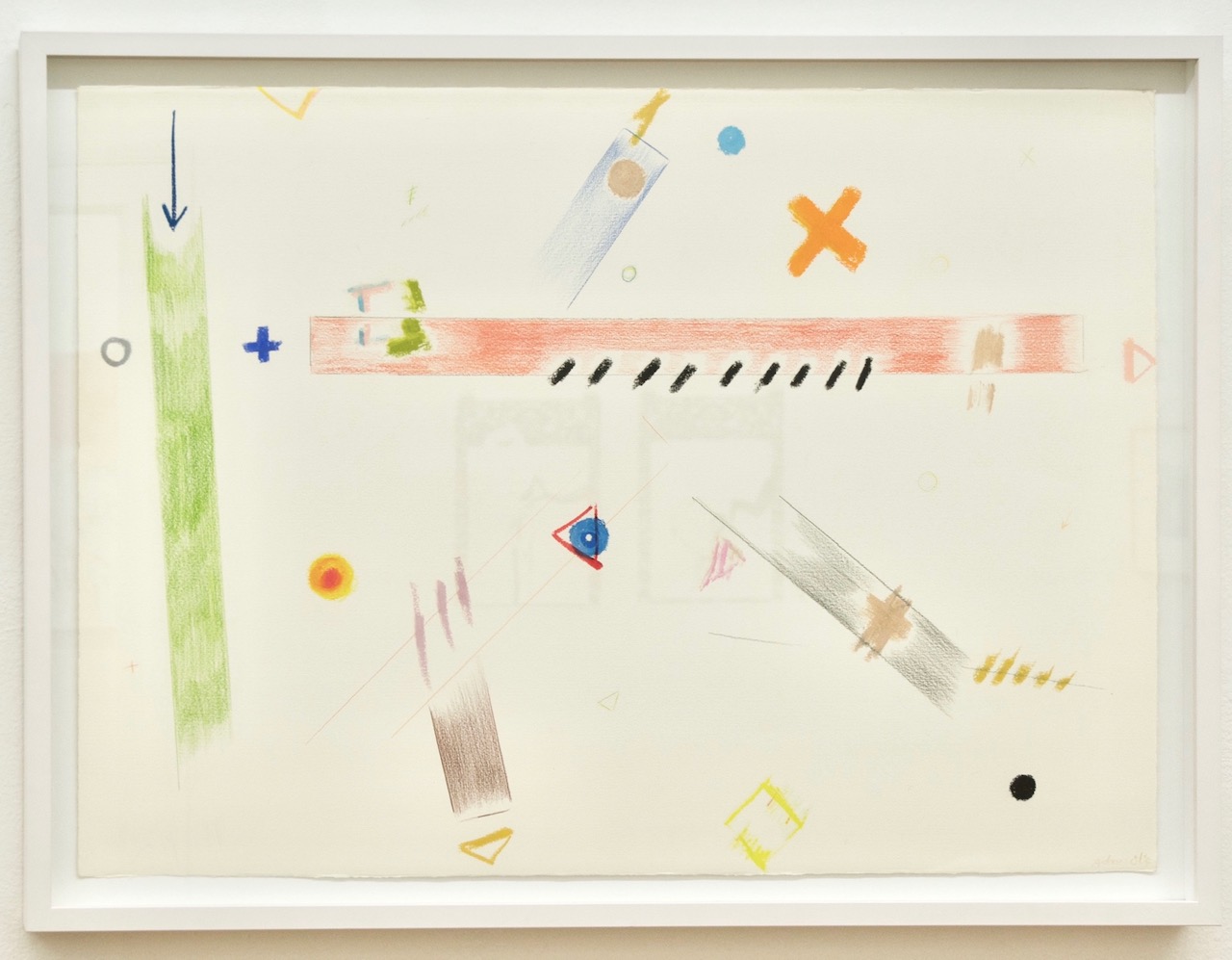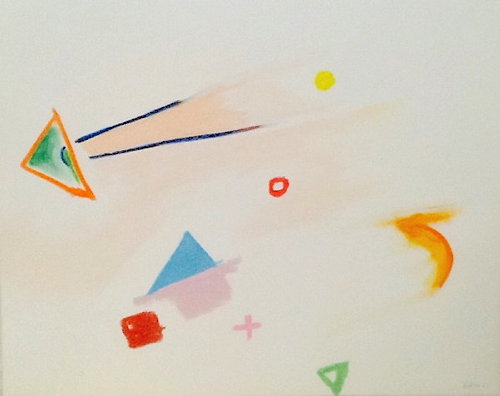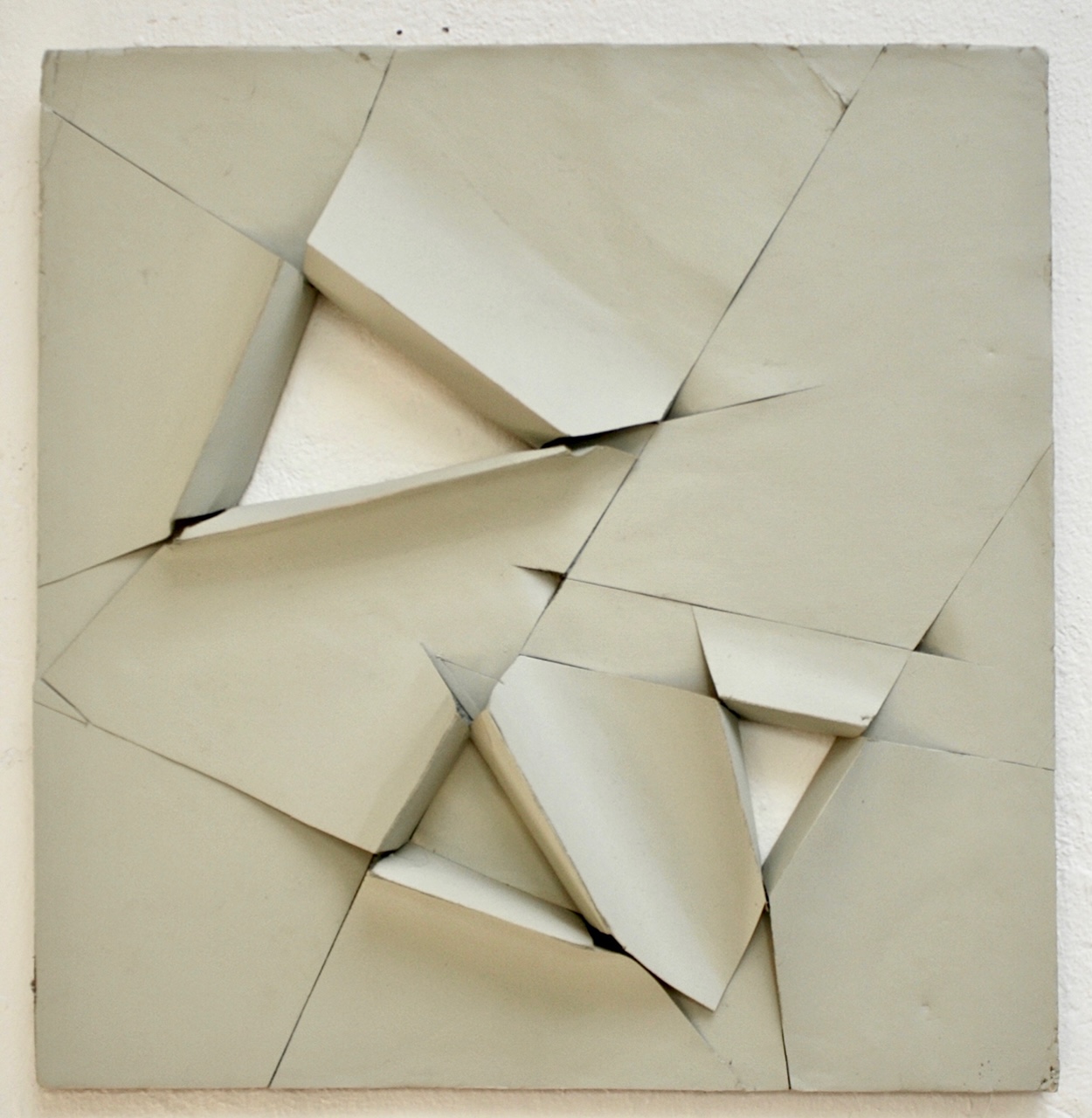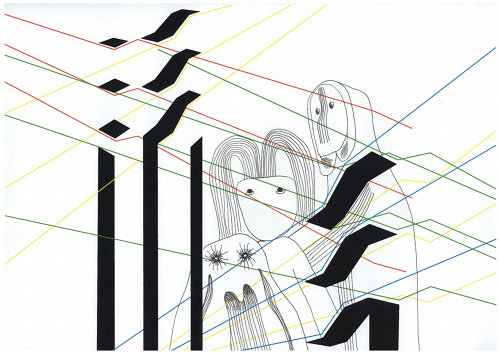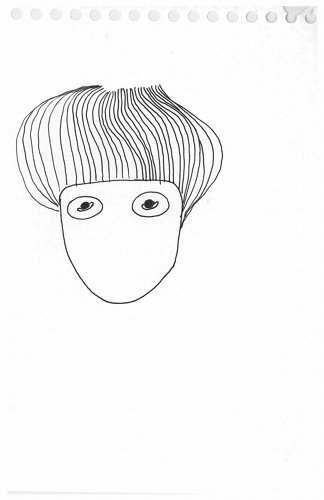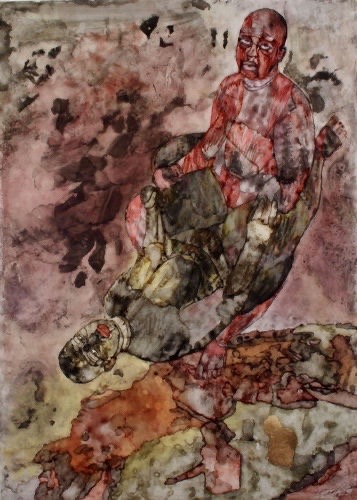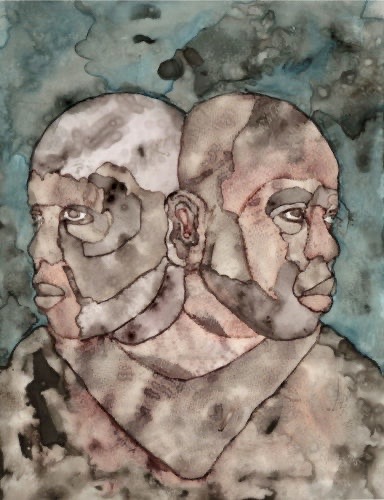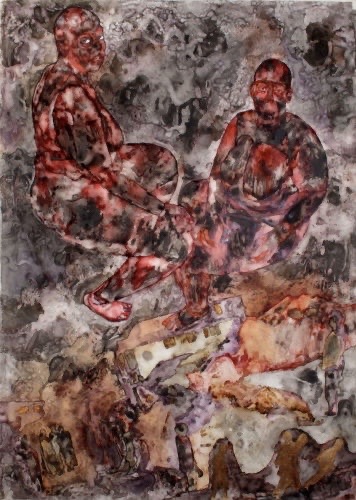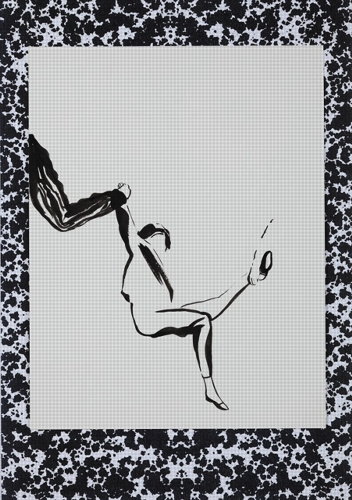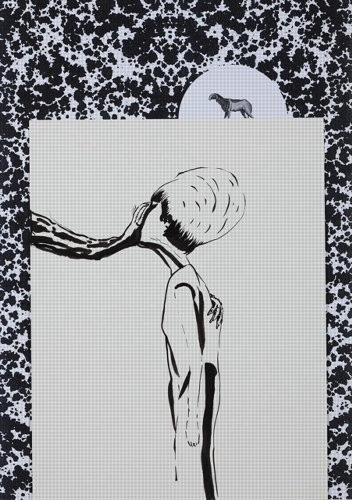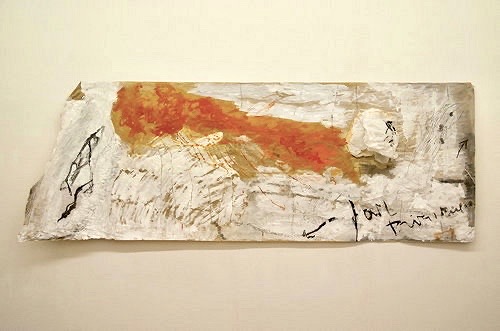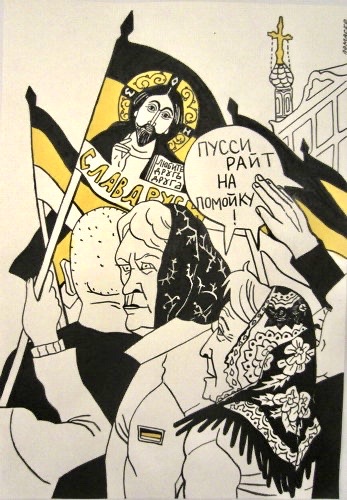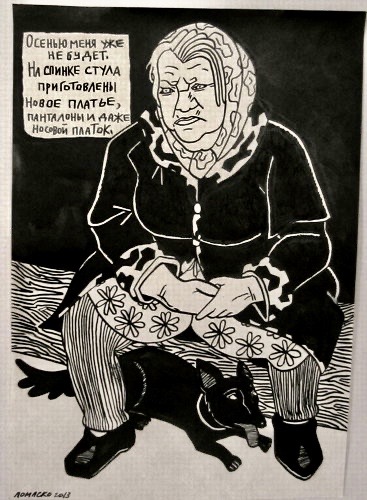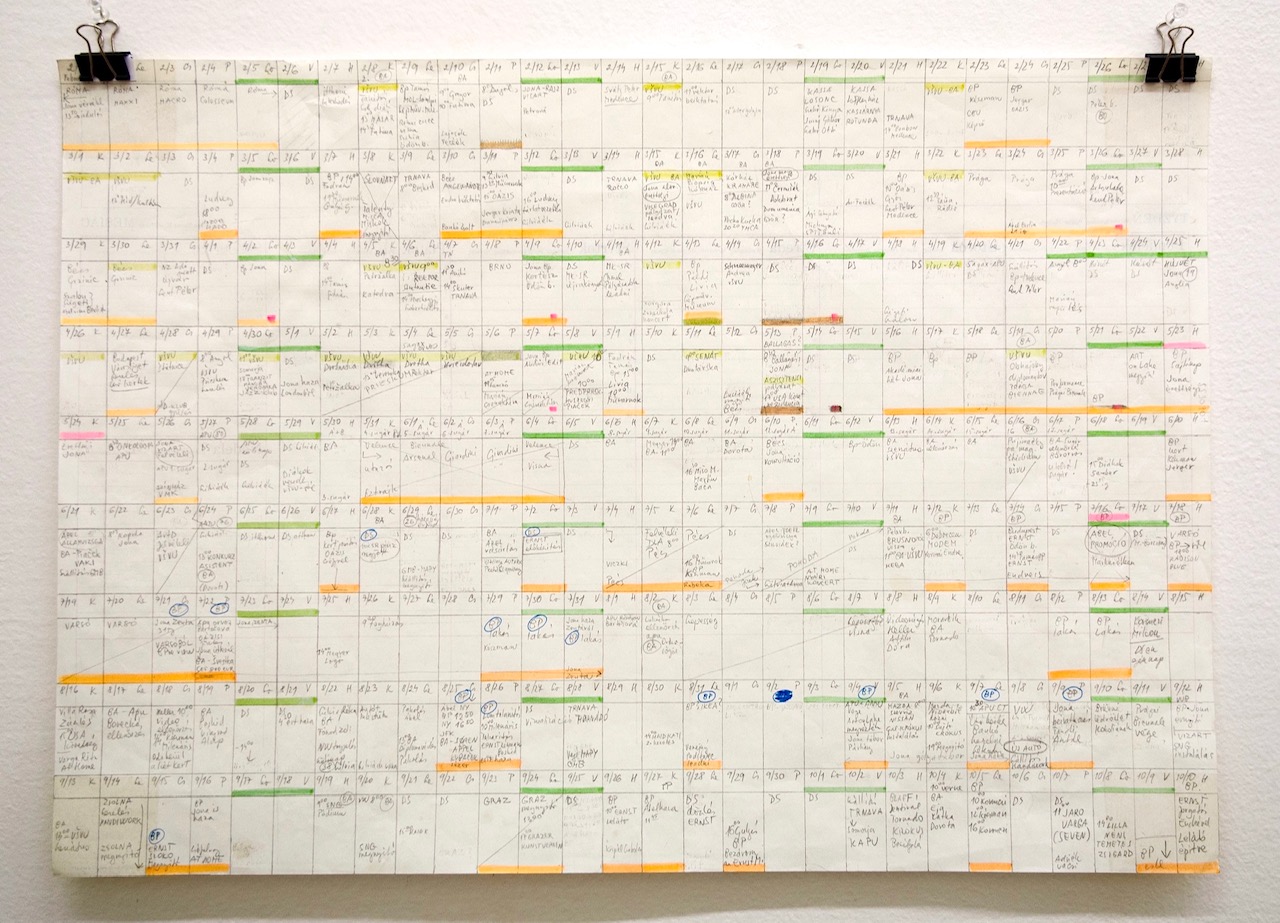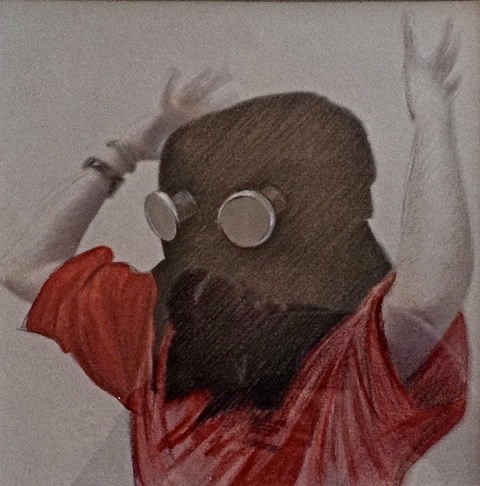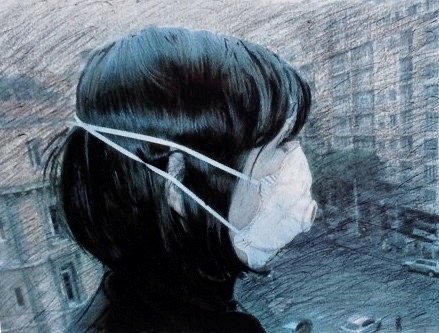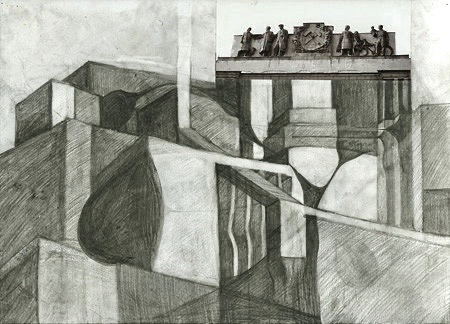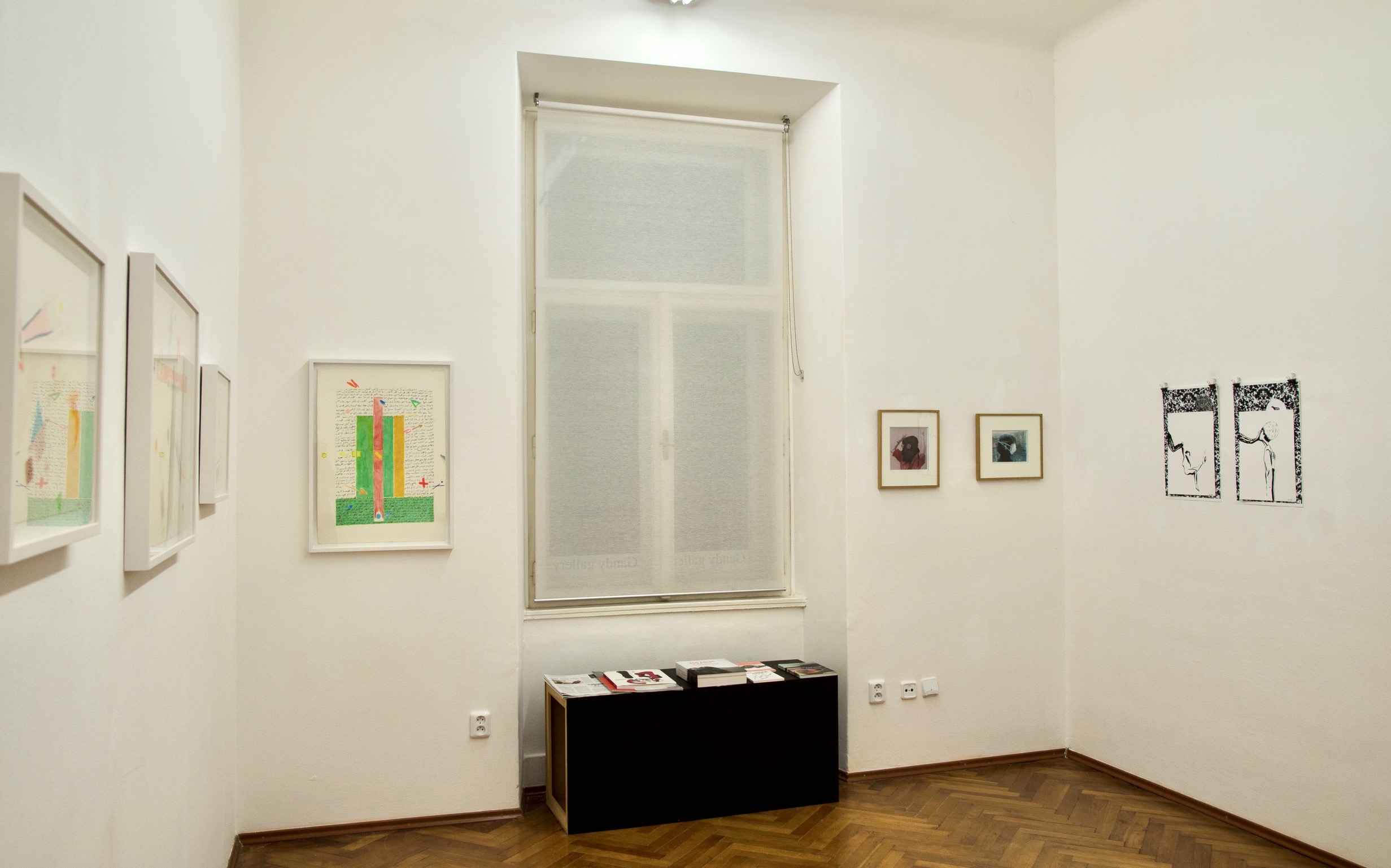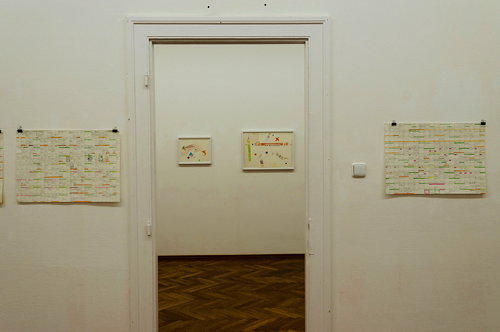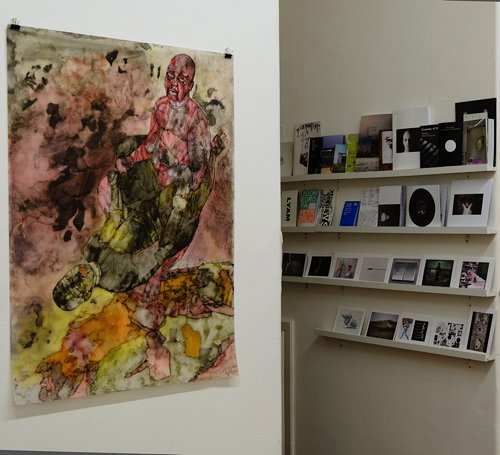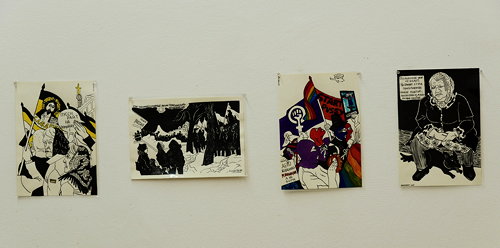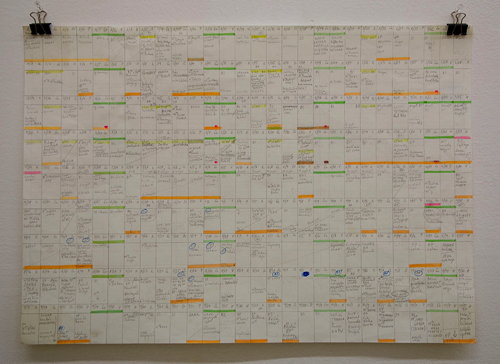Women on Paper
Bratislava
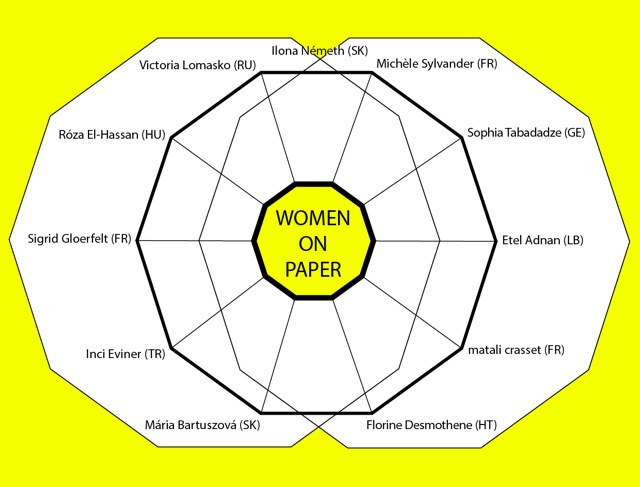
Exhibition: December 12, 2014 - February 27, 2015
Bratislava
ETEL ADNAN
"pastels are saturated with color, and very soft when used, all this makes them a wonderful tool to use, and to follow one's urge to draw. They keep a great freshness, and while watercolors have the beauty of being elusive, pastels have a great presence. They are very close to oils. These pastels were done when I was very involved with Kandinsky particularly, although pastels were not his favorite means. But I liked him for the apparent total freedom of his lines and colors, they always looked like improvisations, and some works were even named that way. When I start one of these kinds of drawings, I never never know where I am going: one mark on paper calls for the next one, and it takes a lot of trust to continue".
Etel Adnan, Paris, December 2014
Born in 1925 in Beirut,lives and works in Paris. She studied philosophy at the Sorbonne, Paris, University of California, Berkeley and Harvard. >From 1958-72, she taught philosophy at Dominican University of California, San Rafael, going on to work as a cultural editor for two daily newspapers in Beirut between 1972-76. Her novel about the Lebanese Civil War, Sitt Marie-Rose, was first published in 1977, winning the France-Pays Arabes Award, and has since been published in more than 10 languages. Her work was recently presented in the solo exhibition "Etel Adnan in All Her Dimensions" at Mathaf: Arab Museum of Modern Art, Doha, Qatar (2014) and was included in the Whitney Biennial, New York (2014) and Documenta 13, Kassel, Germany (2013). Adnan has received numerous awards for her contribution to culture, including, in 2014, France's highest cultural honour, the Ordre de Chevalier des Arts et des Lettres.
MARIA BARTUSZOVA
"In her artistic production, Bartuszová focused on the medium of sculpture, especially with biomorphic and nature-inspired forms. From 1960s she created mainly non-figurative works based on the materialization of the natural processes into the sculpture. Shortly she also experimented with geometrically structured artifacts mainly in the form of abstract aluminium reliefs. But not until the second half of 1970s she started to develop her own sculptural style known for using plaster as a full-valued artistic medium in the combination with various natural materials, such as branches or stones. Another unique structure she was creating from 1980s, was an "ovoid" in the form of subtle and hollow egg."
Born in 1936 in Prague, Czechoslovakia. She studied at the Academy of Arts,Architecture and Design in Prague in the department of ceramics and porcelain. After her studies, in 1963 she moved to Kosice, Slovakia, where she lived until her decease in 1996. In 1970s and 1980s she left several times for Egypt, Paris and London for the artist residencies. Her work was quite neglected during her life even if she embodied one of the most original woman sculptors in Slovak contemporary art. Several solo exhibitions were devoted to Bartuszová’s work, mostly in Slovakia or Germany, but the most important one was held in Slovak national gallery in 2005. Her oeuvre was presented in group exhibitions as well, in Documenta XII, Kassel, Centre Georges Pompidou, Paris, or in MUMOK, Vienna.
MATALI CRASSET
"My relationship to drawing has always been accompanied by a fear of form or of aesthetic. In parallel to my animations which I call soft fictions, I have started to develop an intimate practice of drawings that I realize in shorthand notebooks.
These works on paper are an extension, an activation of possibilities of the soft fictions. I cant help myself questioning what I do, this is what makes me move forward and evolve. It is the reverse of fragmentation, these projects are propulsed forward by a force that synthesizes them and provides a transversal reading.
I like to multiply areas of exploration of our domestic habits and turn them upside down. I also feel the necessity to create large expanses where my imagination can soar, where I can create space for anticipation, soft fictions and small whifs of anticipation to visualize the future… Exhibitions give me the opportunity to materialize this parallel world in the same way a bubble that creates itself, a zone of non voluntary right where creativity can liberate itself and take off from more or less zero.
The soft fictions are a breakaway sufficiently virtual as a platform to dare to experiment. A fiction that occurs as a result of the succession of multiple tiny suppositions that are on the face of it absurd and thrown as examples. This is a fresh vision that provides a coherence to existing projects that are very different from each other (objects, scenographies, architectures) and to creative spaces that are just as playful. How to attempt a new methodology…"
Matali Crasset
Born in 1965 in Chalons en Champagne in France. She lives and works in Paris. Crasset considers design to be research, working from an off-centred position both serving daily routines and tracing future scenarios. With both a knowledgeable and naive view of the world, she questions the obviousness of codes so as to facilitate her breaking these bonds. Like her symbolic work, focused on hospitality, "Quand Jim monte à Paris" (When Jim goes up to Paris) is based on a mere visual and conscious perception which she invents another relation to the everyday space and objects. Her proposals are never towards a simple improvement of what already exists but, without rushing things, to develop typologies structured around principles such as modularity, the principle of an interlacing network, etc. Crasset’s work revolves around searching for new coordination processes and formulating new logics in life. She defines this search as an accompaniment towards the contemporary. Always in search of new territories to explore, she collaborates with eclectic worlds, from crafts to electronic music, from the textiles industry to fair trade, realising projects in set design, furniture, architecture, graphics, collaborations with artists, such as Peter Halley, with young furniture-making companies, as well as with municipalities and communes.
FLORINE DEMOSTHENE
"Demosthene's artwork examines how black culture is commodified and fetishized. Whether through paintings or drawings, she seeks to magnify the subtlety of racial constructs and how viewers have become comfortable with derogatory images. Her most recent work, "The Capture", delves into the subconscious mind of a black heroine and the ephemeral quality of her thoughts and experiences. As she uncovers her special abilities, through a succession of serendipitous events, she comes to understand how these moments of self-realization can be so very temporal. With this new series, she has been intrigued by the black female body as an icon in contemporary imagery and how her physical size is supposed to dictate a certain set of ideals and behavior. "The Capture" is the initial phase to constructing a non-typical black female heroine persona.
Images don't prompt me to create. Words do. I spend and inordinate amount of time reading, writing and researching, before I even approach my canvass. If I am interested in a particular concept, it's nine times out of ten, influenced from reading an essay or an article, rather then looking at a work of art. My artwork toggles between stereotypes and representation and it magnifies the subtlety of racial constructs and how viewers have become comfortable with derogatory images. Whether through paintings, drawings or photographs, I seek to examine how black culture is codified and commodified.
I've been intrigued by the black female body in contemporary visual culture and I'm piqued by how her physical size is suppose to dictate a certain set of ideals and behavior. Borrowing from Jonathan Swifts, "Gulliver's Travels", I chronicled my journey through the Caribbean and West Africa in a series of drawings entitled, The Capture. These mix media pieces, textual mélanges of ink, oil, graphite and charcoal, depict voluptuous female figures amid a strange world of decay and destruction.
The Capture is the initial phase to constructing a non-typical black female heroine persona. By delving into the subconscious mind of a fictitious black heroine and the ephemeral quality of her thoughts and experiences. The Capture is an attempt to structure a new mythology that explores black female sexuality and sensuality."
Lives and work in Accra and New York,earned her BFA from Parsons the New School for Design and her MFA from Hunter College. She has shown extensively through group and solo exhibitions in USA, Caribbean, UK, Slovakia, Germany and Africa. She was a recipient of a Joan Mitchell Foundation Grant in 2011 and she was featured in the premiere issue of Arc (a magazine that is dedicated to highlighting emerging and established Caribbean artists). She's a 2012 Keyholder resident at the Lower East Side Printshop in New York a Guest Artist for the 2014 Dakar Biennale and a participant in the first Kampala Art Biennale in Uganda.
ROZA EL-HASSAN
"The drawings asks how shall we depict the femininity?
Shall it be feminist ? or feminine?
The drawing examines my relation to my own femininity.
What is feminin? the picture, the image of the female body?
or as an alternative a linguistic or a social approach? or the image of a flower?
Instead of all this I take the path of modernist sincerity. The suprematist manifesto suggest the empty sensation, the void floating desert and the autonomous space of art. I start with the sensation of my body and soul without depicting a heavy political statement. The fine rhythm of my body, my emotions, my hormones, my soul, my intellect, the rhythm of time and its sensation. The rhythm and my goal to live a healthy life, a well balanced life, where so many diseases threaten us. Poisons in our food and stress and grief in our soul. I imagine my body, the rhythm of my pulsing veins, the rhythm of desires, my belly, all my illnesses during last decades, my health and my cleansing cures and my reproduction.
The x-rays, the veins,They all make one images, they leave traces on paper.
Waiting time: waiting for decisions, waiting for someone, waiting to an end of loneliness, waiting for you, for an email, for a message, for happiness, for death, for a trip, for a start, for an end, for an arrival."
Roza El-Hassan, Berlin, November, 2014
Born in 1966 in Budapest,lives and work in Budapest and Berlin is one of Hungary’s most prominent contemporary artists. Over the past twenty years, the Hungarian-Syrian artist has acquired an international reputation for her drawings, sculptures, objects, installations, actions, and videos. Her body of drawings is like a golden thread running through her multifaceted, project-oriented oeuvre, which also includes artistic collaborations and curatorial involvement.
She studied at the Hungarian Art Academy, Städelschule, Frankfurt. Solo shows include exhibitions at the Műcsarnok Palace, Budapest; Drawing Center, New York; Secession,Wien and a solo exhibition in Kunstmuseum Basel.She participated in Venice Biennial, Sao Paulo, Kwangju, Sharjah Biennial and many international group exhibitions.
INCI EVINER
"The human figure is central to her work and appears in different techniques that Eviner is using. By means of drawing, photography and video, she forms a tension between the space and performing bodies. This tension operates as an artistic approach revealing what is suppressed and breaking the codes. Her video works performing the uncanny on the stage of reason, deal with issues of identity, in particular female identity through social, cultural, historical or political perspectives. She also addresses the tensions of being a woman in Turkey, a country that embodies the intersection of Asia and Europe. Her intricate drawings combine a finely balanced sense for ornament with hybrid human characters. Of her often disturbing narratives she says that she imagines herself as one of those old-time storytellers who, however, cannot control the story and is eventually swallowed by it."
Inci Eviner is an Istanbul-based artist born in 1956 in Polatli, Turkey. After the graduation from the Istanbul Academy of Fine Arts she was widely exhibited in Europe, Asia and U.S. Solo exhibitions devoted to her work were organized in Paris, Istanbul or Tokyo. She also participated in group shows in Whitechapel Gallery, London, Deutsche Guggenheim, Berlin, as well as in biennals, such as 13th Istanbul Biennal or 4th Asian Art Biennal in Taichung. She was chosen for various artistic residencies, for example for Rockefeller Foundation in Bellagio, Italy, for International Studio and Curatorial Programme in New York or for Cité International des Arts, Paris.
SIGRID GLOERFELT
"Paper…
Rice paper,wrapping paper,parchment paper,recycled paper
Paper…
To draw,to paint,to tell a story
Paper?
A notebook or a diary of a journey…
So many thoughts and an infinity of secrets…
Tear drops,clouds,sorrows…
Paper?
A witness of a lifetime."
Sigrid Gloerfelt, November 2014
Born on a 6th of november grew up between Sweden, Morocco, Spain, France, England studied first in Florence(Belle Arti) then psychology and cinema in London and NYC (NYU) Met Rodolphe Stadler in 1990 and had a long collaboration with him Lived in a bewildering array of countries South Africa,India,Switzerland,Italy,Lebanon where i had exhibitions…
VICTORIA LOMASKO (Chto Delat)
"is Moscow-based artist, curator, feminist and activist. She was born in 1978 in Serpukhov, Russia. In 2003 she graduated from the Moscow State University of Printing Arts where she majored in graphic art and book design. In her reportage work, Lomasko explores current Russian society, especially the inner workings of the country’s diverse communities and groups, such as Russian Orthodox believers, LGBT activists, underage prostitutes, migrant workers, sex workers and collective farm workers. She is mainly known for a series of exhibitions and graphic reports focusing on the politically motivated trials, such as that of feminist punk band Pussy Riot, street protests or the existence of prisoners in penal colonies.
In 2010 she published Drawing lesson, a calendar comprising portraits from the Mozhaisk children’s penalty colony, where she taught underage prisoners to draw. In collaboration with Anton Nikolayev she co-authored in 2011 the documentary graphic novel Forbidden Art about the trial of Moscow art curators convicted of inciting religious hatred. She is also a co-curator of two long-term projects combining art and activism, Our Courtroom Drawings (with Zlata Ponirovska) and Feminist Pencil (with Nadya Plungian)."
ILONA NEMETH
Ilona Németh uses various media, such as objects, installations, videos or art in public space. In the 1990s the characteristic feature of her production was the utilization of specific natural and organic materials (water, clay, hair, etc.) or the site-specific installations created for the space of former synagogues among others. At that time she also started to focus on the current social problems which took the form of projects based on a sociological research. In the end of the 1990s, first interactive installations appeared in her work what allowed a spectator to have a direct experience with the artwork. this drawing is from the series of papers of my diary.
"I am using this format from the year 2007. This type of activity is some kind of thinking about my work and activities, dealing with my future. Making this plan with own 'design" with pencil is an important daily routine of my life."
Ilona Nemeth
Born in 1963 in Dunajská Streda, Czechoslovakia, where she currently lives and works. Between 1981 and 1986 she studied in Budapest at the Hungarian Academy of Applied Arts at the Department of typography and typographic art. Since 2004 she is in charge of the Studio "IN" at the Department of intermedia and multimedia at the Academy of Fine Arts in Bratislava. During her career she obtained several awards and scholarships and she participated in numerous exhibitions in Slovakia, as well as abroad, for example in Moderna Museet, Stockholm, MUMOK, Vienna, or at the 49. Venice Biennal. Her works are also part of several collections in Slovakia, Hungary or United States.
MICHELE SYLVANDER
Philippe Vergne wrote about Michèle Sylvander in her catalogue called "Droit de visite":
"The idea of framing is important in Michele Sylvander's work so much so that it is at the heart of her photographic research.
Frame the world, cut and deform images. There is a real obsession with "seeing" in her work, her own as well as that of the other. Her images don't document action.
They are more concerned with composition, a nearly pictorial need to give form to an experience that's either personal and intimate or generic and ordinary." MS works on the ambiguity of images.
Between reality and fiction, the images that she reveals question sexual codes, identity, the body politic and social. Her work is based mainly on photography, but installation, drawing and video are also present.
The drawings shown at Gandy Gallery are from the Personna series. These works are derived from photographs transferred onto paper and enhanced with colored pencil. They refer to the mask, the one that each individual wears in public.
Philippe Vergne is director of MOCA, Los Angeles, USA
Born in 1944,lives and works in Marseille. Michèle Sylvander practiced painting until 1986 before turning to photographic self-portraiture. This series of images led her to staged photographic self-imagery. The body becoming to her the obvious symbol of a possible answer to the question of identity.
SOPHIA TABADADZE
"I use architectural forms to show the human condition: architecture lives longer than human beings, while perfectly reflecting their condition and circumstances. When social orders collapse, the first thing people react to, or destroy, is the architecture representing that order. It is the perfect object of revenge".
Sophia Tabadadze
Born in 1977 in Tbilisi, Georgia, is of both origins, Dutch and Georgian. She currently lives in Tbilisi and Berlin. In 2002 Tabatadze obtained her diploma from Gerrit Rietveld Academie in Amsterdam and also frequented School of Visual Arts in New York. She participated in numerous exhibitions in Georgia and abroad including solo shows in Berlin, Rotterdam, Amsterdam and Tbilisi, as well as group exhibitions, biennals and fairs. Some of works are also part of collections, such as Transitland, Artist Pention Trust and Opymos Collection. Tabatadze uses different techniques, mostly installation, video and performance. Her work deals with human body in (new) surroundings and with a human being in relation to architecture. "Home" is a reccurent topic in her installations, as a temporary place that exists during the building up process only and that can be left behind like a shell after it is completed. Tabatadze's pieces are not related to one specific location, be it her homeland, Georgia, or the lands overseas, they still remain relevant. The human condition in a global village, reduced to ornamental motives, reflected in architectural innovations, pieces of embroidery or snaps of phrases, applies to anyone. The paradigmatic changes in the society are traced here in the changes of façade decor, city posters message, contents of popular diets, linguistic metaphors. It takes particular courage to speak up when everyone is silent, or to reveal something that everyone wants to hide. She makes this attempt in an unobstrusive, artistic language of symbolic metaphors, chains of associations and subtle analogies.
